Dr Jane Williams

Are you the despairing parent of a “…mine, mine, MINE!” toddler, where everything is theirs and nothing is for sharing? Well, I have just learned something that will help you feel a lot more positive about this stage of development!
Dr Gerry Leisman (2018), highly regarded for his research into the relationship between movement and learning, presented an interesting insight into the importance of the ‘mine’ and ‘me’ stage of development, so apparent in our 2+ year-old toddlers.
The ability to recognise one-self does not occur until a child is between 16 to 18 months of age. We know this through the very clever ‘mirror test’. When a child younger than 16 to 18 months sees themselves in the mirror they try to pick a sticker, stuck on their own forehead, off the child in the mirror. Whereas, a child older than 18 months will try to pick the sticker off their own forehead! (You can see this test on YouTube if you type in self-recognition mirror test). Soon after 18 months of age, a child also begins to use personal pronouns, such as their own name, or ‘me’ and ‘mine’, and this has an important effect on the storage of memories and how the brain wires up! As soon as you add in the idea of ‘me’, learning and memory is enhanced.
Dr Leisman explains: “Regardless of how children feel about themselves, adding an ‘idea of me’ to their cognitive architecture changes the way they process information. For example, as adults, we remember very few childhood events. One intuitive explanation for ‘childhood amnesia’ is that, until memories can be related to oneself, they are very difficult to store and retrieve. Once a sense of self is established (from the age of 16 to 18 months), information is more easily retained if it relates to the child (‘self-reference effect’ on memory).
From three years of age, children are more likely to remember objects linked with themselves rather than those linked with others. Children between four and six years of age, when asked to sort pictures of shopping items into their own basket or a basket of another, accurately remember more of the items that they ‘owned’. The self-reference effect occurs because items linked with the self, attract additional attention and memory support within the brain.
Doing something that relates to self, changes how children process information. This becomes apparent when, after the age of 16 to 18 month, a child recognises him or herself and “Mine” becomes the oft heard cry, and is very true after the age of three, when a child is increasingly self-aware and the prefrontal cortex is more engaged.
What can you do as parents?
To assist the development of long term memories, try linking new ideas and actions to the child’s actual self. For example, self-reference effects happen when a child talks about ‘my book’, as it attracts additional attention and memory support within the brain, ensuring that the information about self is not lost. Self-reference can be used to help children learn more easily and swiftly: “Who’s book is this in the Treasure Bag?” “Whose toy?” “Is that yours Elizabeth?” “Yes! That’s mine!”
At many GymbaROO/KindyROO centres, we encourage parents and children to bring along their own Treasure Bag item and this research reinforces exactly why this is important. By bringing in their own recognisable Treasure Bag object, children are more likely to lay down the long-term memories that can be recalled and utilised to inform future encounters and interactions.
So, don’t despair! ‘Mine’ is an important stage of development that really kick starts self-awareness and memory, both important for future understanding and learning.
Reference:
Leisman, Gerry (2018.) “I’ and “Thou”: Cognitive-motor interaction in the development of individuation. Presentation at the Movement and Cognition conference, Harvard University Medical School, July 2018.

